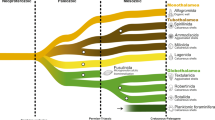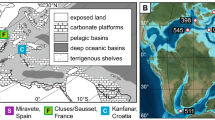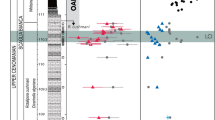Abstract
Intraspecific coiling variations of the planktonic foraminifer Neogloboquadrina pachyderma (Ehrenberg) form an important micropalaeontological technique for the palaeoclimatic interpretation of late Cenozoic mid-latitude marine sediments. In all the modern oceans, this species preferentially coils dextrally in subtropical to temperate latitudes and sinistrally in subpolar to polar latitudes1,2. Plankton3–5 and surface sediment studies6–20 of the North Pacific clearly associate sinistral populations with subarctic water masses and dextral populations with temperate subtropical regions. Here we show that down-core ratios of sinistral to dextral coiling, when correlated with oxygen isotopes, indicate major late Quaternary southward advances of the subarctic boundary (polar front) and the Oyashio Current during oxygen isotope stages 2,4 and 6.
This is a preview of subscription content, access via your institution
Access options
Subscribe to this journal
Receive 51 print issues and online access
$199.00 per year
only $3.90 per issue
Buy this article
- Purchase on Springer Link
- Instant access to full article PDF
Prices may be subject to local taxes which are calculated during checkout
Similar content being viewed by others
References
Parker, F. L. in Micropalaeontology of Oceans (eds Funnell, B. M. & Riedel, W. R.) 289–307 (Cambridge University Press, 1971).
Bé, A. W. H. in Ocean Micropalaeontology Vol. 1 (ed. Ramsey, A. T. S.) 1–100 (Academic,London, 1977).
Bradshaw, J. S. Cushman Fdn Foram. Res. Contr. 10, 25–64 (1959).
Smith, A. B. Cushman Fdn Foram. Res. Contr. 14, 1–15 (1963).
Banerji, R. K., Schafer, C. T. & Vine, R. Atlantic Ocean Lab., Bedford Inst., Rep. 1971–7 (1971).
Bandy, O. L. Bull geol. Soc. Am. 70, 1708 (1959); J. Paleont. 34, 671–681 (1960); in Tertiary Correlations and Climatic Changes in the Pacific (ed. Hatai, K.) 95–102 (11th Pacific Sci. Congress, Tokyo, 1967); Palaeogeogr. Palaeoclimatol. Palaeoecol. 5, 63–75 (1968).
Ingle, J. C. Jr, Bull. Am. Paleont. 52, 217 (1967); Init. Rep. DSDP Leg 18, 517–567, 949–960 (1973).
Shchedrina, Z. G. Akad. Nauk SSSR, Trudy Inst. Zool. 13, 12–32 (1953).
Saidova, Kh. M. Dokl. Akad. Nauk SSSR 14, 1302–1305 (1957).
Asano, K. Sci. Rep. Tohoku Univ. 2nd Ser. 28, 26 p. (1957).
Lipps, J. H. & Warme, J. E. Cushman Fdn Foram. Res. Contr. 17, 125–134 (1966).
Belyeava, N. V. Oceanology 9, 500–504 (1969).
Kent, D. V., Opdyke, N. D. & Ewing, M. Bull. geol. Soc. Am. 82, 2741–2754 (1971).
Wollin, G., Ericson, D. B. & Ewing, M. in The Late Cenozoic Glacial Ages (ed. Turekian, K. K.) 199–214 (Yale University Press, New Haven, 1971).
Echols, R. J. Init. Rep. DSDP Leg 18, 721–735 (1973).
Vincent, E. Init. Rep. DSDP Leg 32, 765–801 (1975).
Maiya, S., Saito, T. & Sato, T. in Progress in Micropaleontology (eds Takayanagi, Y. & Saito,T.) 395–422 (Micropaleontology Press, New York, 1976).
Keller, G. Mar. Micropaleont. 3, 97–119 (1978).
Kitazato, H. Geol. Surv. Japan, Cruise Rep. 11, 56–58 (1978).
Thompson, P. R., thesis, Tohoku Imperial Univ. (1977).
U.S. Naval Oceanographic Office, Spec. Pub. 123 (US Government Printing Office, Washington, 1969).
Hays, J. D. & Shackleton, N. J. Geology 6, 649–652 (1976).
Shackleton, N. J. Phil. Trans. R. Soc. B280, 169–182 (1977).
Thompson, P. R. Init. Rep. DSDP Leg 56 (in the press).
Thompson, P. R., Bé, A. W. H., Duplessy, J. C. & Shackleton, N. J. Nature 280, 554–558 (1979).
Conolly, J. R. & Ewing, M. Mem. Geol. Soc. Am. 126, 219–231 (1970).
Thompson, P. R. J. foram. res. 6, 208–227 (1976).
Jousé, A. P. in Micropalaeontology of Oceans (eds Funnell, B. M. & Riedel, W. R.) 407–422 (Cambridge University Press, 1971).
CLIMAP Science 191, 1131–1137 (1976).
Omori, M. Deep Sea Res. 14, 525–532 (1967).
Chinzei, K. Proc. 1st. Int. Congr. Pacific Neogene Stratigraphy (eds Saito, T. & Ujiié, H.) 327–330 (Geological Survey of Japan, Tokyo, 1977).
Fuji, N. Proc. Jap. Acad. 49, 737–741 (1973).
Ujiié, H. & Ichikura, M. Trans. Proc. Paleont. Soc. Japan 91, 137–150 (1973).
Ingle, J. C. Jr Init. Rep. DSDP Leg 31, 693–701 (1975).
Ichikura, M. & Ujiié, H. Bull. natn. Sci. Mus., Tokyo C2, 151–178 (1976).
Kato, M. Geol. Surv. Jap., Cruise Rep. 10, 59–62 (1978).
Author information
Authors and Affiliations
Rights and permissions
About this article
Cite this article
Thompson, P., Shackleton, N. North Pacific palaeoceanography: late Quaternary coiling variations of planktonic foraminifer Neogloboquadrina pachyderma. Nature 287, 829–833 (1980). https://doi.org/10.1038/287829a0
Received:
Accepted:
Issue Date:
DOI: https://doi.org/10.1038/287829a0
This article is cited by
-
Paleoceanography of the northwestern Pacific across the Early–Middle Pleistocene boundary (Marine Isotope Stages 20–18)
Progress in Earth and Planetary Science (2021)
-
Glacial sea surface temperature of the East Sea (Japan Sea) inferred from planktonic foraminiferal assemblage
Geosciences Journal (2010)
-
Biomarker records from core GH02-1030 off Tokachi in the northwestern Pacific over the last 23,000 years: Environmental changes during the last deglaciation
Journal of Oceanography (2009)
Comments
By submitting a comment you agree to abide by our Terms and Community Guidelines. If you find something abusive or that does not comply with our terms or guidelines please flag it as inappropriate.



